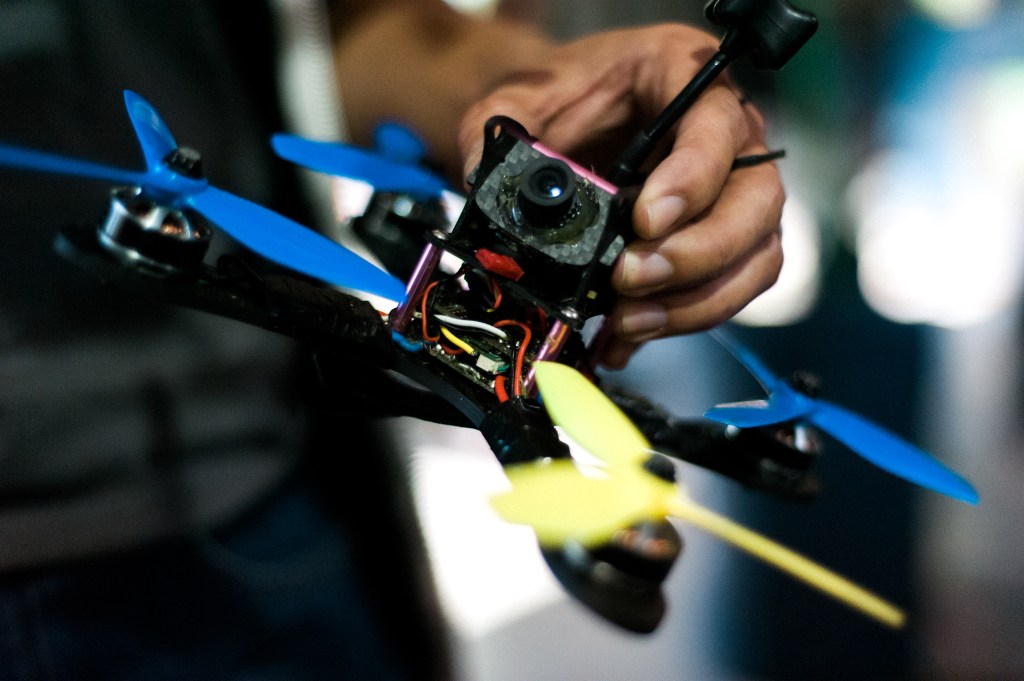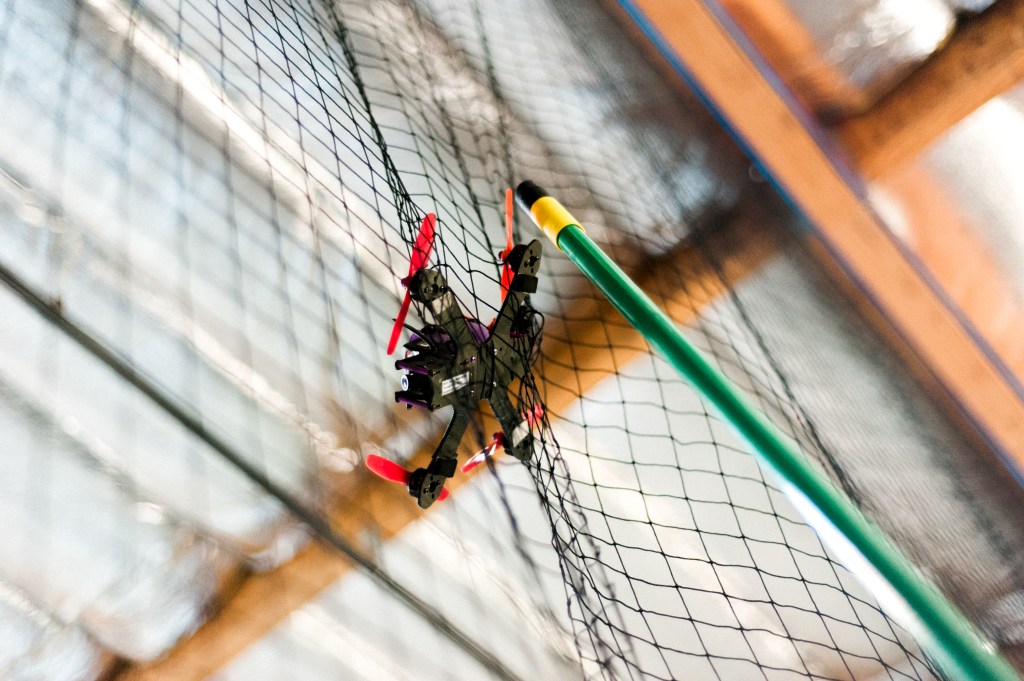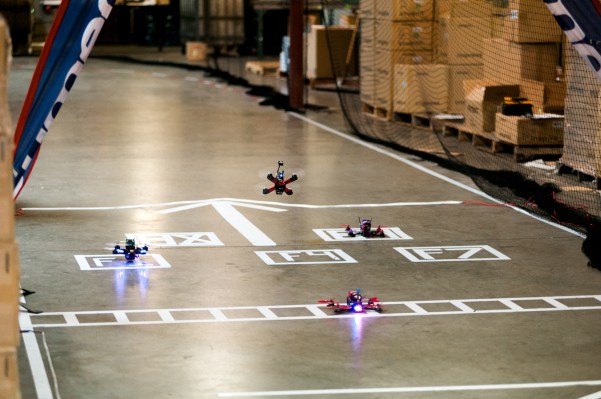I am standing behind a stack of boxes in a warehouse in Fremont, 15 miles north of San Jose.
Bzzz! Bzzz! Bzzz!
Three drones whiz by at highway speeds as I clutch a cardboard shield close to my face. They turn sideways as they navigate a corner and then right themselves before ducking under an arch. After rounding two more turns, they fly over the finish line of the drone-racing course.
The pilots, sitting behind a black net a few meters away, wear headsets that display a live stream from the camera affixed to their respective drones. Their thumbs fiddle with the joysticks on their controllers. From their stoic faces, it’s hard to tell they are rocketing through the air at 50 miles per hour.
Many of these pilots are professional athletes. They travel the world competing for drone-racing titles, which are beginning to carry hefty purses thanks to the money pouring into the sport. One year ago, it would have been almost impossible to call yourself a professional drone racer. Today, however, a select few are leaving their day jobs to pursue the sport full time.
As drone pilots step out of isolated hobbyist groups and into the spotlight, many are asking themselves the same question: What will it take to make drone racing a sport acknowledged and embraced the world over?

A handful of drone
Pilots compete in different classes based on the size and style of their drones. They tend to have technical knowledge they use to heavily modify their drones, plus repair it between races. (Image: Ash Ponders)
The watershed moment
In 2014, Scot Refsland started a Berkeley-based group for drone hobbyists. Over the course of a year, it grew from 10 to 700 people. Other cities and countries saw the same trend; as quadcopters found their way into local stores and onto the news, the hobby picked up enthusiasts in unprecedented numbers.
People have been flying remote-control aircraft for decades. Many picked up the hobby via an interest in electronics or models, and they tended to focus on freestyle tricks or simply flying via line-of-sight piloting. But groups like Refsland’s marked a departure from the hobby’s past. They prefer first-person-view (FPV) headsets, which allow pilots to step into the eyes of their drones. Some liked setting up flags and racing their drones.
“There was immediate war between these two groups online and in person at the clubs,” said Sean Wendland, a Sacramento-based pilot who runs an FPV news site, several forums and the think tank Flight Club. “Everybody deemed us unsafe, malicious, pirates — all of these things.”
At this time last year, drone racing generally amounted to a few people chipping in to buy flags to mark the boundaries of a racetrack. Refsland, who is a virtual reality and computer scientist by training, began considering how to turn disparate groups of people flying drones in fields into a competitive sport.
The result was Drone Nationals, which took place last July in a stadium on the California State Fair grounds. Over the course of two days, 120 pilots worked their way around a twisty track in hot California sunshine.
Suddenly, professional drone racing became very real.
“About a year ago, we were producing these drone racing events and these combat events and there was sort of this watershed moment where everyone got the bug with racing,” said Marque Cornblatt, who runs a series of drone racing and combat events called Aerial Sports League. He attributed the timing to FPV headsets, which allow you to “forget your true body, your true form, and believe you are in that cockpit of that drone at 60, 70 miles per hour and crashing without having bodily harm to yourself.
That same month, Drone Racing League held a race in an abandoned power station in New York. The drones carried brightly colored LEDs and raced through crumbling corridors marked by even more lights. High-production videos brought the race to the Internet. The International Drone Racing Association (IDRA) launched and began ranking pilots globally.
Suddenly, professional drone racing became very real.
Images: Yashad Kulkarni
Racing in Fremont
The Fremont event is casual. It’s a local gathering of some of the Bay Area’s best pilots, but also a group of guys who get together during the week to practice flying in parks.
They go by nicknames like M0ke and Flying Bear — variations on the traditional call signs favored by aviators, but also the handles they used when they first met in online forums.
There are minor celebrities in attendance, too. Ken “Flying Bear” Loo travels the world competing in drone races. An engineer, he started flying drones as an extension of his love for remote control cars. He built his first racing drone with the help of his home 3D printer. Now he practices whenever he can squeeze in time outside of work.
As the Fremont race draws on, co-organizer and competitor Colby Curtola barks the names of on-deck pilots in his California skater-guy drawl.
The pilots who make it to the final races here just have to survive — smooth, careful flying often beats out reckless laps at higher speeds. The focus shifts from flying as fast as possible in the qualifying rounds to just surviving the dizzying turns around the warehouse’s boxes and out its back loading doors.
From time to time, pilots untangle each other’s drones from the net after crashes. They repair their aircraft with soldering irons and hot glue guns between races.

A tangled end
When one drone finds itself caught on protective netting, rescuing it becomes a community endeavor. Races tend to be local affairs where the pilots all know each other. (Image: Ash Ponders)
The drone racer
Unlike the consumer photography quadcopters that rose to prominence a few years ago, racing drones is still fairly DIY. As a result, their users tend to have an interest in electronics — just like the decades of RC fliers before them. They are often engineers or IT professionals, with access to and experience with the tools needed to work on a drone.
Heather McDowell is a pediatric nurse in Texas who flies fixed wing drones, which look like planes instead of four-rotor helicopters. She appears in videos and does her best to make the sport more appealing to women, but she still has yet to race against another woman.
“We call it FPV therapy because while you’re flying FPV, you can’t think about anything else going on in life,” McDowell said. “All you can think about is what you’re doing right then. It’s a break from reality.”
Luke Bannister, a 15-year-old from the U.K. known as Banni UK, currently sits atop the IDRA’s rankings. He won March’s Grand Drone Prix, an international event complete with a custom course, announcer and high-tech touches that made it one of the splashiest competitions yet.
Drone racing is still wide open for anyone who wants to compete.
Most pilots attribute kids like Bannister’s skills to a lifetime of playing video games and young reflexes.
I spoke with 11-year-old Cadence Hazakins, also known as KrazyK, who started flying with her dad. While she has never been interested in video games or working with electronics, she spent months practicing flying in a simulator before touching a real drone. Now, she looks forward to racing whenever it’s possible.
What’s clear is that drone racing is still wide open for anyone who wants to compete. In the 10 months since drone racing became a serious sport, pilots’ ranks have risen and fallen. A pilot can achieve international acclaim and then fall off the list completely, because the skill requirements change so fast. Few people have been flying drones for longer than a few years, and racing experience tends to be even more sparse. Last year, practicing flying every day might have been enough to make you one of the best racers in the world.
That’s slowly changing, but standouts still rise to prominence quickly.
Reinventing drone racing
The entire drone community watched the Drone Grand Prix in Dubai with interest. Funded and run by a wealthy family, the event hosted a high-profile mix of private money and sponsored pilots. The course itself took the form of a raised track resembling a giant snake skeleton.
The organizers stumbled on some of their promises the first day. Drone events require the coordination of dozens of radio signals so pilots and spectators can control or watch the right drone. There are flashy light shows and live streams to think about. By the end, the Grand Prix had all these things.
Growing drone racing requires a mix of pleasing pilots, spectators and sponsors.
“That was the first time that everybody saw what live racing looks like with money behind it,” Refsland said. “That really showed the world drone racing from a professional level is pretty substantial.” He said the race made his phone ring with calls from investors.
Growing drone racing requires a mix of pleasing pilots, spectators and sponsors, according to Nick Horbaczewski, who is the CEO of the Drone Racing League. Spectators mean more sponsors and investors. Sponsors and investors mean more money, which means more pilots. More pilots mean more companies will invest in drone technology, which means more equipment options and a potential drop in costs.
But as drone racing grows more professional, some pilots are raising alarm bells. RC pilots flew for decades without serious interest from the public or government. Now that more people — including reckless beginners — are picking up drones, the FAA is swooping in with new rules that threaten an FPV pilot’s way of life.
There’s also anxiety as money pours in from people without experience with drones. Pandering to spectators and sponsors means compromising pilots’ ideas of the perfect race.
“The whole identity of the hobby is at stake,” says Wendland, who spoke out strongly against the existence of professional drone racing leagues. “If we allow enough investors to just take it and repackage it, then it’s gone. We’ll have lost our culture.”
It’s a painful evolution the world has seen several times over the last few decades. When snowboarding debuted, it delighted its small group of experimentalists. Then it grew and many ski resorts banned it. Eventually, it became an accepted part of snow-sport culture. But the cycle dictates that as sponsors cash in, inventors feel forgotten.
If we allow enough investors to just take it and repackage it, then it’s gone. We’ll have lost our culture.
Horbaczewski argued that drone racing’s global momentum ensured it would have burst into the public eye at some point, even without major investors. Most people I interviewed spoke in favor of having a variety of drone racing events, from the local to the international level.
Loo is already dreaming of the day he can quit his job and start racing drones full time — something that becomes more possible as the sport continues to grow. Others are talking about a skate park model, which would provide safe spaces for hobbyists to fly and find other enthusiasts.
Images: Ash Ponders
Sharing with the world
If investors want to bring drone racing to the world, then they need to solve the spectator problem. Drones tend to be about four or five inches across and get lost in the expanse of a warehouse or stadium.
“You’re talking about things that are basically the size of a dinner plate going 80 miles an hour on a three-dimensional course, so they can be very hard to see,” said Horbaczewski. “We’ve worked very hard on the sports cinematography side … in order to film the drones in a way that makes them as compelling as possible to the viewer.”
The Drone Racing League allows a small amount of spectators into its events, which have taken place in venues like the Miami Dolphins Stadium. But most people access its events through its videos, which feature close-ups of drones whizzing through lit-up rings and laughing pilots. A lot of effort is put into making the sport look exciting.
If investors want to bring drone racing to the world, then they need to solve the spectator problem.
Equipping drones with brightly colored lights is another early attempt to make drones easier to view. This year’s Drone Nationals competition will also feature a division for drones larger than 6 inches across. And niches like McDowell’s fixed-wing planes, which are even larger and brightly colored, could continue to grow in popularity.
At the Fremont event, there are about a dozen spectators interspersed with the pilots. There’s a woman who brought her large photography drone to fly in the parking lot, plus parents cradling babies to their chests. Other spectators don the same FPV headsets as the pilots and compare to which drone’s broadcast channel they’ve tuned. At several points, a drone runs smack into a wall, eliciting an appreciative “Ooooooo!” from the audience.
From my vantage point in the center of the course, it’s pure excitement. It’s aerial Nascar racing, complete with collisions that cause drones to burst into pieces. Back on the other side of the net, I pull on an FPV headset and see through the same eyes as a pilot. It’s this view that convinces me drone racing can be a spectator sport. Who among us doesn’t want to experience flying?
There was a twinge of bittersweetness as the winning pilots stepped to the top of a podium thrown together from warehouse pallets to accept their awards. Travis “M0ke” McIntyre, who won the tournament that day, is also a highly ranked Drone Racing League competitor.
At this point in the sport, professional drone racers are still turning to forums and local meetups for the kinship with fellow pilots they’ve wanted for so long. But as professional drone leagues create opportunities for pilots to leave behind their past lives, they will.
Lead image by Ash Ponders. Video shot and edited by Yashad Kulkarni.
